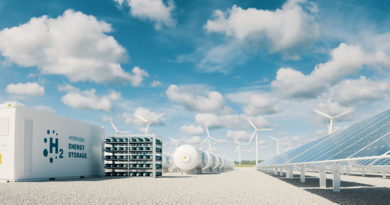
How renewable materials can power a circular economy
The population is growing fast. Resources are finite. The circular economy is no longer an option. It is an increasingly inevitable necessity. The only question is how to accelerate the transition to a more circular economy, in which we minimise waste and resource consumption, even as we maximize consumer utility.
The increasingly alarming impacts of climate change will force us to go beyond renewable energy, energy efficiency and forestation in our climate action. We must consider the considerable climate action potential of pre- and re-cycling goods and materials. We must recognise that climate action and the circular transition are mutually reinforcing, because circularity will reduce material, energy, and water use, as well as CO2 emissions. According to estimates, the circular economy has the potential to close a significant portion of the gap between current policies and the Paris Agreement’s 1.5 degrees Celsius target that, otherwise, seems more and more difficult to reach.
The potential of the circular economy to replace fossil-based and other non-renewable materials with renewable ones is often overlooked. These could be obtained from wood, crop residues and bio-waste to produce packaging, textiles, chemical and construction material, for example. If based on sustainable feedstocks, such a shift has the potential to decrease carbon emissions and to reduce the dependency on finite and fossil resources.
In circular economy discussions, we often think of the biodegradability of renewable materials. These materials, however, also have the potential for reuse, remanufacturing, and recycling. According to the European Paper Recycling Council, in 2020, 73.9% of all paper and board consumed in Europe was recycled.
As their name suggests, renewable materials are regenerative. By definition, nature’s systems are circular. Still, we must be careful not to over-extract or deplete renewable materials for industrial production. We must think about the impact on local ecosystems and consider the interface with other land uses, in particular for agriculture, to ensure that the extraction of renewable materials for consumer goods and packaging materials is acceptable and sustainable.
As a matter of principle, the substitution of fossil-based materials and goods by renewable ones, for packaging for example, should be carefully assessed, according to the full life cycle impacts.
Apart from energy and fertilisers used for production and transport, sustainably managed and extracted biomass is carbon-neutral1. Under these conditions, sustainable materials promote enhanced carbon fixation and/or short-term compensation in sustainably managed areas.
Renewable products and packaging produced from extracted carbon-neutral biomass and wood can act as temporary renewable carbon removals (i.e., negative CO2 emissions), as they prolong the CO2 sequestration from their natural carbon cycles. These carbon-removal effects can be significantly extended over time, when biomaterials and paper are reused or recycled.
Cascading and long-lasting utilisation of recycled biomaterials is an effective way to increase the life span of these products for human use. They may go through several different uses, with life spans from less than two years (for wood energy) to several decades (as wood panels).
At the end of its life, biomaterial can be composted or digested, returning organic material and nutrients to the biosphere. Even if they were incinerated, they would create no net fossil CO2 emissions, because they replaced fossil energies.
Reuse and recycling of renewable materials has environmental and climate benefits. By reducing the harvesting of virgin materials in a cost-efficient way, the net benefit of capturing and then converting materials back into the economy is positive. Even systems with high recycling rates, such as the paper packaging industry, still need recourse to a certain amount of renewable, virgin material to compensate for losses and wear in the recycling process. For example, paper fibres in the carton board industry can be recycled on average more than seven times. In each recycling process, a certain percentage of fibre breaks into smaller strings, up to a level where it loses its technical characteristics and needs to be discarded.
There is an abundance of sources for renewable materials in forestry, agricultural and marine biomass, and from bio-waste of different types. But there are still limits. Extracted materials should be responsibly sourced and used efficiently to improve overall socio-economic welfare and health, while maintaining the growth and renewal capacity of the resource. It is also crucial to ensure that renewable materials are used in applications whose potential for circular production and consumption is the highest. That’s done by life cycle impact assessments of carbon and material footprints.
Responsible sourcing standards, such as the Forest Stewardship Council and the Sustainable Biomass Program, are good tools to ensure a sustainable sourcing of renewable materials. In the frame of long-term sustainable production and extraction of biomass, we should aim for so-called second-generation feedstock – residues and by-products from forestry, agriculture, industry, or waste streams of different kinds.
With all these benefits, why is the replacement of non-renewable materials not much more common?
There are several general reasons and market failures behind the slow replacement process, including lack of consumer awareness of the benefits, and underdeveloped logistics that lead to high collection costs relative to the value of goods and materials recovered.
But technical limitations also apply. Take wooden products:
· The separation of wood waste contaminated by preservatives, paints and glue has some constraints. Improved techniques for sweeping and separating waste are expensive, and it remains difficult to sort the biomass waste fully automatically at a reasonable cost.
· The collection of products and the separation at source of wood from demolition and post-consumer, household biomass presents a challenge. It could be addressed through separate collection, standardization of biomass waste, and the labelling of reusable products.
· There is no pan-European obligation for source separation of recyclable wood and other bio-materials, as there is for glass, plastics, metal and paper. Regulations governing the maximum acceptable contaminants in particleboard vary from country to country.
Recycling activity should increase and be up-scaled rapidly, with further technology and system developments, combined with higher consumer awareness and corporate responsibility, provided relevant investors have access to funding and financing.
There is room for more research and demonstration on how and for which applications renewable materials could be used as substitute for fossil and non-renewable materials. As demonstrated above for wood and other bio-materials, there is also a need to further develop the circular reuse and recycling aspects of renewable and non-renewable materials, and to raise awareness through communication to end users and in the manufacturing sector.
Value chain collaboration, which is at the core of a circular economy, needs improvement, too. This requires investment in infrastructure and logistics to scale and improve the economics of high-quality recycling, as well as infrastructure and systems for reverse logistics.
Supporting the bioeconomy and a more circular use of renewable materials is high on the European Investment Bank’s agenda.
We financed PKN Orlen, a Polish oil refiner and petrol retailer, for the construction and operation of: a new centre for research and development of renewable chemical and biofuels technologies; an industrial demonstration facility for the production of 25 kt/year of sustainable, second generation sugars and bioethanol from cereal straw that can serve as biofuel, as well as primary materials for the production of bioplastics; and an innovative bio-propylene-glycol production unit with a capacity of 30 kt/year from biogenic glycerine.
Another of our projects upgrades and modernizes an integrated pulp and paper mill in Obbola, Sweden, resulting in further expansion of the production of recyclable and compostable packaging solutions from recycled pulp and renewable and sustainable wood sources. An important component of this project was the increase in the generation of renewable energy on site, so that the plant can cover all its thermal energy needs virtually without using fossil fuels.
At the European Investment Bank, we recognise the need to increase and develop our diversity of funding instruments for circular bioeconomy. Together with the European Commission, we contributed to setting up the European Circular Bioeconomy Fund, which is the first venture capital impact fund exclusively dedicated to the (circular) bioeconomy. The Fund targets growth-stage companies with a high potential for innovation, favourable returns, and sustainable impact. It offers flexible financing tools from equity to mezzanine.
From agritech to and biotech, blue economy and bio-based chemicals, circular investment has a high priority.




